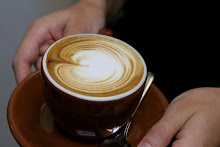
We will be hosting a public viewing of the First Presidential Debate next weekend at Black Sheep-
7:00 P.M. Fireside Lounge- big screen T.V. We will be serving appetizers as provided by Volunteers for Obama, and serving our full coffee, tea, and dessert menu as well as our extended lunch menu throughout the event.
And now on the the blog:
As promised, here are some great photos from our last roasting session.
The profiles are really starting to produce consistently delicious results- and we continue to tweak the slope and length of the plane through first crack on the Kenya, Guatemala, and Brazil.
Here are some macro photos of Bean color transformation throughout the Roast. Times and further profile data to follow.
 Just through the warming stage- bean temperature- 300
Just through the warming stage- bean temperature- 300
+ 1 minute, 320 degrees
 342 degrees
342 degrees 364 degrees, starting to ramp down to first crack. (back off on heat to slow rate of change from +20 per minute to +4-8 per minute depending on bean elevation and density.)
364 degrees, starting to ramp down to first crack. (back off on heat to slow rate of change from +20 per minute to +4-8 per minute depending on bean elevation and density.) 408 degrees, 1st crack +4 minutes +8 minutes in the cooling tray. Beans are deeply mottled and smell clean and vaguely sweet. No baked aroma or discernible roast taste at all.
408 degrees, 1st crack +4 minutes +8 minutes in the cooling tray. Beans are deeply mottled and smell clean and vaguely sweet. No baked aroma or discernible roast taste at all.And here are macro photographs of our Teas- to be used to make our Tea Menu pages.
 Ornamental green tea. Three Flower Burst Tea
Ornamental green tea. Three Flower Burst Tea Lapsang Souchong- a China Black Smoked tea.
Lapsang Souchong- a China Black Smoked tea. Gunung Dempo
Gunung Dempo 100 Monkeys White Tea
100 Monkeys White Tea Ti Kwan Yin Iron Goddess of Mercy Oolong Tea. Odd name but excellent tea.
Ti Kwan Yin Iron Goddess of Mercy Oolong Tea. Odd name but excellent tea. Orange Sencha- Green Japanese Sencha flavored with Oranges.
Orange Sencha- Green Japanese Sencha flavored with Oranges. Provence Roobios Blend- delicious with blueberries, etc.
Provence Roobios Blend- delicious with blueberries, etc.Here is a couple of photos of the Obama volunteers meeting last night, as well as Rosie playing Guitar!
And a couple of Javier's artwork- On Display at the Sheep until October!














